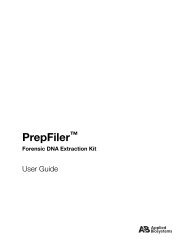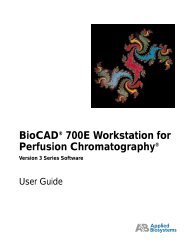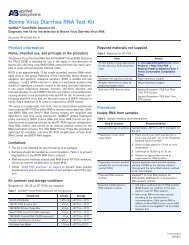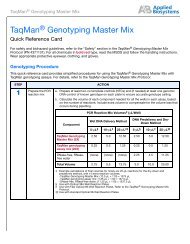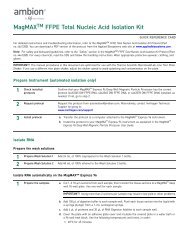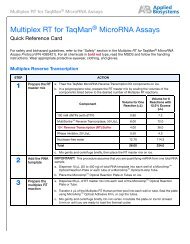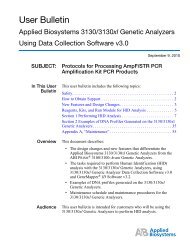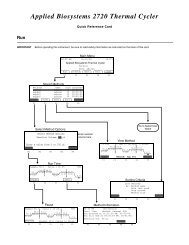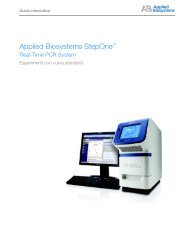700.http://iai.asm.org/cgi/content/abstract/72/2/691Type IV pili (Tfp) of gram-negative species share many characteristics, including a commonarchitecture <strong>and</strong> conserved biogenesis pathway. Much less is known about the regulation of Tfpexpression in response to changing environmental conditions. We investigated the diversity of Tfpregulatory systems by searching for the molecular basis of the reported variable expression of theTfp gene cluster of the pathogen Actinobacillus pleuropneumoniae. Despite the presence of anintact Tfp gene cluster consisting of four genes, apfABCD, no Tfp were formed under st<strong>and</strong>ardgrowth conditions. Sequence analysis of the predicted major subunit protein ApfA showed anatypical alanine residue at position -1 from the prepilin peptidase cleavage site in 42 strains. Thisalanine deviates from the consensus glycine at this position in Tfp from other species. Yet,cloning of the apfABCD genes under a constitutive promoter in A. pleuropneumoniae resulted inpilin <strong>and</strong> Tfp assembly. Tfp promoter-luxAB reporter gene fusions demonstrated that the Tfppromoter was intact but tightly regulated. Promoter activity varied with bacterial growth phase <strong>and</strong>was detected only when bacteria were grown in chemically defined medium. Infectionexperiments with cultured epithelial cells demonstrated that Tfp promoter activity was upregulatedupon adherence of the pathogen to primary cultures of lung epithelial cells. Nonadherent bacteriain the culture supernatant exhibited virtually no promoter activity. A similar upregulation of Tfppromoter activity was observed in vivo during experimental infection of pigs. The host cellcontact-induced <strong>and</strong> in vivo-upregulated Tfp promoter activity in A. pleuropneumoniae adds anew dimension to the diversity of Tfp regulation.Sommer, F., H. Wilken, et al. (2004). "Systemic Th1 Immunization of Mice against Helicobacter pyloriInfection with CpG Oligodeoxynucleotides as Adjuvants Does Not Protect from Infection butEnhances Gastritis." Infect. Immun. 72(2): 1029-1035.http://iai.asm.org/cgi/content/abstract/72/2/1029Recent reports have suggested that oral vaccination of mice against Helicobacter pylori isdependent on a Th1-mediated immune response. However, oral vaccination in mice neitherinduces sterilizing immunity nor leads to complete protection from disease. Therefore, in thisstudy we investigated whether a systemic subcutaneous immunization against H. pylori by usingCpG oligodeoxynucleotides as a Th1 adjuvant could achieve protection in a mouse model of H.pylori infection. CpG oligodeoxynucleotides are known for their ability to induce nearly entirelyTh1-biased immune responses <strong>and</strong> may be approved for human use in future. Immunization ofmice with H. pylori lysate <strong>and</strong> CpG induced a strong local <strong>and</strong> systemic Th1 immune response.Despite this strong Th1 response, mice were not protected from infection with H. pylori yet had a10-fold reduction in the number of H. pylori in the gastric mucosa compared to nonimmunizedmice. Of note, reduction of the bacterial density in immunized mice was accompanied by asignificantly enhanced gastritis. Hence, systemic Th1 immunization of mice, even though beingable to reduce the bacterial load in the stomach, is associated with aggravated pathology.Giuliani, M. M., L. Santini, et al. (2005). "The Region Comprising Amino Acids 100 to 255 of Neisseriameningitidis Lipoprotein GNA 1870 Elicits Bactericidal Antibodies." Infect. Immun. 73(2): 1151-1160.http://iai.asm.org/cgi/content/abstract/73/2/1151GNA 1870 is a novel surface-exposed lipoprotein, identified by genome analysis of Neisseria
meningitidis strain MC58, which induces bactericidal antibodies. Three sequence variants of theprotein were shown to be sufficient to induce bactericidal antibodies against a panel of strainsrepresentative of the diversity of serogroup B meningococci. Here, we studied the antigenic <strong>and</strong>immunogenic properties of GNA 1870, which for convenience was divided into domains A, B, <strong>and</strong>C. The immune responses of mice immunized with each of the three variants were tested usingoverlapping peptides scanning the entire protein length <strong>and</strong> using recombinant fragments. Wefound that while most of the linear epitopes are located in the A domain, the bactericidalantibodies are directed against conformational epitopes located in the BC domain. This was alsoconfirmed by the isolation of a bactericidal murine monoclonal antibody, which failed to recognizelinear peptides on the A, B, <strong>and</strong> C domains separately but recognized a conformational epitopeformed only by the combination of the B <strong>and</strong> C domains. Arginine in position 204 was identifiedas important for binding of the monoclonal antibody. The identification of the region containingbactericidal epitopes is an important step in the design of new vaccines against meningococci.Savkovic, S. D., J. Villanueva, et al. (2005). "Mouse Model of Enteropathogenic Escherichia coliInfection." Infect. Immun. 73(2): 1161-1170.http://iai.asm.org/cgi/content/abstract/73/2/1161Enteropathogenic Escherichia coli (EPEC) is an important cause of diarrhea in humans. EPECinfection of cultured intestinal epithelial cells induces attaching <strong>and</strong> effacing (A/E) lesions, altersintestinal ion transport, increases paracellular permeability, <strong>and</strong> stimulates inflammation. The lackof a small-animal model has restricted in vivo studies examining EPEC-host interactions. The aimof this study was to characterize the C57BL/6J mouse as a model of EPEC infection. We haveshown that EPEC can adhere to <strong>and</strong> colonize the intestinal epithelium of C57BL/6J mice. Animalweight <strong>and</strong> water intake were not altered during 10 days of EPEC infection. The proximal colon ofinfected mice contained semisolid stool, with stool pellets forming only in the distal colon. Incontrast, the entire colon of control mice contained formed stool. Microvillous effacement <strong>and</strong>actin rearrangement, characteristic of A/E lesions, were seen in the intestine of infected mice butnot control mice. Histological assessment revealed increased numbers of lamina proprianeutrophils with occasional crypt abscesses, intraepithelial lymphocytes, <strong>and</strong> goblet cells in theintestine of EPEC-infected mice. Altogether, these data suggest that the C57BL/6J mouse issusceptible to infection by EPEC <strong>and</strong> will provide a suitable in vivo model for studying theconsequences of EPEC infection.Lohr, C. V., F. R. Rurangirwa, et al. (2002). "Specific Expression of Anaplasma marginale Major SurfaceProtein 2 Salivary Gl<strong>and</strong> Variants Occurs in the Midgut <strong>and</strong> Is an Early Event during TickTransmission." Infect. Immun. 70(1): 114-120.http://iai.asm.org/cgi/content/abstract/70/1/114Infectivity of Anaplasma spp. develops when infected ticks feed on a mammalian host(transmission feed). Specific Anaplasma marginale major surface protein 2 (MSP2) variants areselected for within the tick <strong>and</strong> are expressed within the salivary gl<strong>and</strong>s. The aims of this studywere to determine when <strong>and</strong> where MSP2 variant selection occurs in the tick, how MSP2expression is regulated in salivary gl<strong>and</strong>s of transmission-feeding ticks, <strong>and</strong> whether the numberof A. marginale organisms per salivary gl<strong>and</strong> is significantly increased during transmissionfeeding. The South Idaho strain of A. marginale was used, as MSP2 expression is restricted totwo variants, SGV1 <strong>and</strong> SGV2, in Dermacentor <strong>and</strong>ersoni. Using Western blot, real-time PCR,<strong>and</strong> <strong>DNA</strong> sequencing analyses it was shown that restriction <strong>and</strong> expression of MSP2 occurs earlyin the midgut within the first 48 h of the blood meal, when ticks acquire infection. A. marginale ispresent in the tick salivary gl<strong>and</strong>s before transmission feeding is initiated, but the msp2 mRNA



